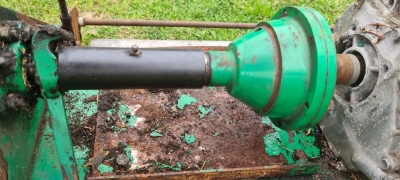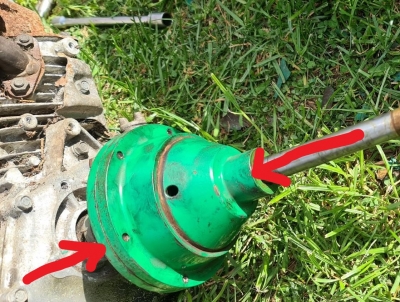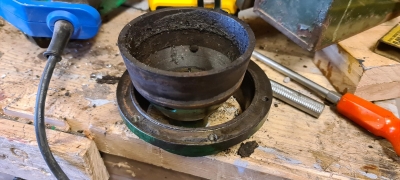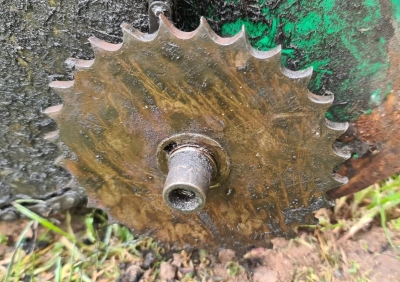Green's Zephyr 20" Clutch - Is it stuck and how do I fix it?
I recently acquired a Green's Zephyr 20 powered by a Honda GX110 engine, which has been stood for at least a year. It seems to be a sturdily made machine although a number of maintenance and repair tasks are needed. It has a dog clutch on the side and appears to have a cone clutch on the main drive. The cone clutch doesn't seem to disengage, pulling the cable just seems to lever away the steel plate to the left, on which the lever has its fulcrum mounted. What's the standard approach to determining whether this is indeed stuck, and freeing it? I assume starting point is to strip it down, i.e. remove the clutch and then to squeeze it in a vice. Any pointers? I'm keen not to take it off unnecessarily, and aware of the risks of doing more damage than good.

Forums
Right, a slight update... I
Right, a slight update... I've popped the engine and clutch off, and from what I can see, I need to compress the actual casing of the clutch to disengage / free it. Is that correct? i.e. compress the green thing where the two arrows are:

Thanks @wristpin. Am I right
Thanks @wristpin. Am I right in thinking it's the two outer parts of the clutch which move themselves? That's not just a fixed casing, is it?
Years since I touched one of
Years since I touched one of these, but from memory, the way it works is that the male part of the clutch is supposed to be be moved towards the engine by the green lever (operated by the cable) pushing the black tube.
If you have removed all the retaining screws from the female cone (the ones that hold it to the plate on the engine crankshaft) and it didn't fly apart, then the male cone is stuck to the female cone, probably by rust. You could try using a hot air gun on the female cone, but I would put the retaining screws back in again, slightly undone. You may be really unlucky and find the male cone part is also stuck on the shaft, in which case, I would remove the engine and then the shaft from the machine and work on it on a bench.
Thanks Hortimech. Looks like
Thanks Hortimech. Looks like good advice. I did indeed loosen the six bolts and it showed no signs of coming apart, even after a tap with a hammer. I'll try some heat as you suggest. Do you know how the shaft is removed? I can't get it in a vice with the shaft in. Thee shaft is quite long, it goes in the chain side. On the engine side, there's a hole in the middle revealing a centre bolt possibly within a bearing. But loosening the bolt didn't free the shaft. Do you think that the bolt retains the shaft, and I need to take the bolt out and then drift the shaft out? Once that's done I should be able to squeeze it in a vice.
Right, thanks for that - it
Right, thanks for that - it worked! The heat separated the end plate and that took the shaft out with it. Then with the shaft out of the way I was able to crack the cones in the vice. It just appears to be a pair of steel cones one inside the other with no friction material. Does that sound right? Or do you think it's just worn away and I need to acquire some friction material and glue it in?

I don't remember any friction
I don't remember any friction material, it was metal to metal contact (similar to a an Atco 28/34 clutch), but it has been about 40 years since I worked on these, so I may be remembering incorrectly, but If there was any friction material involved, it would expect it to be riveted, the glues back then weren't very good.
That’s good news, and yes, it
That’s good news, and yes, it’s metal to metal. Many years ago when Atco used a similar metal to metal cone clutch on the Groundsman , a customer of mine left his machine barely covered for the winter and when he found the clutch seized tipped a “ bucket” of diesel over it. The oil seemed to be absorbed into the clutch metal and nothing would stop it slipping. We ended up boiling the cup and cone in a saucepan of water laced with Vim which liberated the oil. The moral of the story is don’t oil cone clutches other than very sparingly on the sliding components.
This may be of use.
https://www.dropbox.com/s/jbukg41bpdyk9p4/Greens%20Zephyr0002.pdf?dl=0
A bit out of topic I know,
A bit out of topic I know, but some engines on bigger Howard rotavators used similar dry cast iron cone clutches, I do remember repairing a few of those, of course soil was also a problem with them when it got inside the 'works' not just rust, one I sorted was worn away badly.
Thanks @wristpin you're a
Thanks @wristpin you're a superstar. I fear I may have already accidentally lubricated the clutch friction plates and reassembled it ☹
The diagram in that manual 99% tallies up. On mine the drive sprocket on the rear drum appears to be retained with a circlip, rather than the locking nut labelled 72 in the manual. I was hoping to get it off and reverse it because the teeth are badly worn but removing the circlip doesn't free it. It's on a spindle with a key in a slot and the spindle is hollow with a thread down the inside. I presume the hollow is to transmit grease and the thread is for a missing grease nipple. Any ideas how this sprocket is freed?

Almost certainly just a push
Almost certainly just a push fit over the shaft and key and retained by the ciclip, BUT time and corrosion may have taken their toll and it may resist removal. Try some heat around it’s centre and then very cautious use of a three leg puller, but stop at any sign that the sprocket is bending rather than moving. I suspect that the boss on the sprocket is too deep to allow your idea of reversing it, unless that is, you have the knowledge and wherewithal to cut it off and re-weld it to the other side.
, Edit. Just looked at the parts list and that sprocket does have a deep centre , so unless you are going to re- engineer, I’d leave it alone.
The lubricator is No 70 on the bearing block inside the frame.


You could try a pan of
You could try a pan of boiling water all round the cone and follow it up by tapping all around it with a copper hammer.
or, it looks as though the back plate - nearest to the motor - is bolted to the female cone . If it is and it will separate, and with the motor out of the way, you may be able to tap that part free of the male cone.
Alternatively there may be someone here who’s been there, done it, and knows what they ‘re talking about!